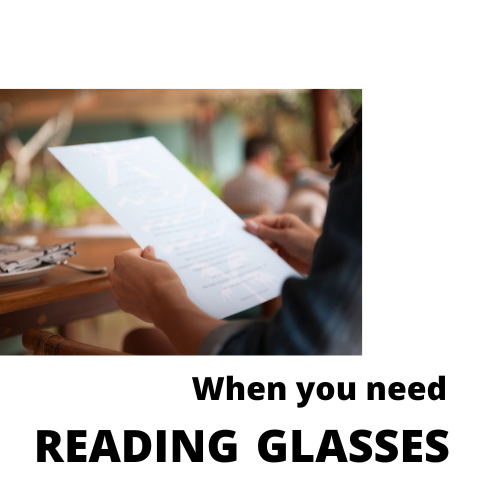When You Need Reading Glasses?


When do you need reading glasses?
If you you need reading glasses for small print that used to be easy for you to read, you are most likely experiencing the symptoms of presbyopia.
Presbyopia is a Greek term combining the word “presbus” which means old man, with the word “op” which means eye. So, it literally means “old man eyes.”
As we age the lenses in our eyes become stiff and less flexible. Normally, the muscles around the lens (ciliary muscles) contract and reshape the soft flexible lens allowing small print to be focused. As we age, the lens becomes stiffer and less flexible, thus, near vision is blurred because our focusing muscles simply are no longer able to reshape a stiffer lens.
Reading Glasses are Normal
As early as age 10 the natural lenses in your eyes begin to gradually stiffen, and little-by-little lose their ability to change shape to clearly accommodate close-up vision. Although there is no way to reverse this process, it is easy to treat.
Reading glasses are a simple and safe way to correct presbyopia. You may be able to use over-the-counter (nonprescription) reading glasses. But if you already wear glasses then the best option is to have the lower part of your eyeglass lenses fitted with a magnification boost for your near vision. That boost of magnification power can be added in a progressive lens in which there is no line indicating where it goes from far to near vision correction.
Non-Prescription Reading Glasses
If you don’t wear glasses then you can try different non-prescription reading glasses to see which magnification power lens works best for you. They range from +1.00 diopter and increase in +0.25 increments. The highest over-the-counter magnification reading glasses are +3.5 diopters. Magnification in eyeglass lenses above +3.5 diopters is available, but you need a prescription for those lenses.
Non-prescription reading glasses are relatively inexpensive and most people who need them keep several pairs handy around their home and in their cars so they are readily available when needed.
These are some signs that you may have presbyopia:
- You are holding books and other reading material farther away to be able to focus on them
- You have trouble seeing smaller print in dim light
- Your eye hurt when you try to read or do other close-up work
- You get headaches after reading
You may also notice that you are becoming more sensitive to light and glare due to other aging changes in your eye. In this case, reading glasses with an anti-reflective coating would help.
If you are beginning to notice the signs of presbyopia, it is a good idea to schedule an eye exam to check the overall health of your eyes.
The American Academy of Ophthalmology recommends a comprehensive eye examination at age 40. An eye exam can also detect early signs of eye disease that can begin without symptoms. The best outcome for any eye disease is when it is diagnosed and treated in the early stages.
Gregory Scimeca, M.D.
Ophthalmologist and Medical Director
The Eye Professionals
Our Locations
